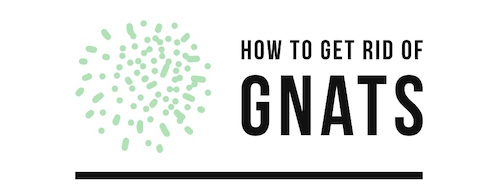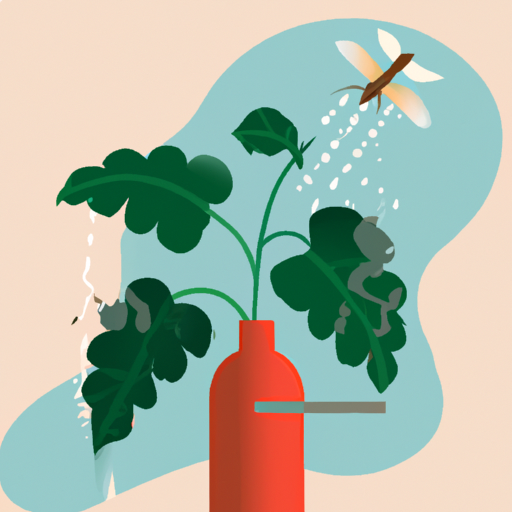How to Identify Gnats in Plants and What to Do About Them
Gnats are small, flying insects that can be found in and around plants. They are often mistaken for fruit flies, but they are actually different species. Gnats feed on the sap of plants and can cause damage to foliage and flowers. Identifying gnats in plants is important so that you can take steps to control them before they become a problem.
To identify gnats in plants, look for small black or gray insects hovering around the plant’s leaves or stems. They may also be seen crawling on the soil surface near the plant’s roots. If you see these insects, it is likely that you have a gnat infestation.
Once you have identified gnats in your plants, there are several steps you can take to control them:
1) Remove any decaying organic matter from around your plants as this will attract more gnats;
2) Use sticky traps or yellow cards to capture adult gnats;
3) Apply an insecticidal soap or neem oil solution directly onto affected areas of your plant;
4) Introduce beneficial nematodes into the soil which will attack larvae; and
5) Increase air circulation by pruning back dense foliage and using fans near affected areas of your garden.
By following these steps, you should be able to reduce the number of gnats in your garden and protect your plants from further damage caused by these pests.
Natural Ways to Get Rid of Gnats in Houseplants
Gnats are a common problem in houseplants, but there are several natural ways to get rid of them.
1. Remove any decaying plant material from the soil and dispose of it outside. This will help reduce the number of gnats in your houseplant.
2. Place yellow sticky traps near the plant to attract and trap adult gnats. These traps can be purchased at most garden centers or online stores.
3. Make a homemade insecticidal soap by mixing 1 tablespoon of liquid dish soap with 1 quart of water in a spray bottle and spray it on the leaves and stems of your houseplant to kill any gnats that may be present on them.
4. Use neem oil as an organic pesticide to control gnat populations in your houseplants by spraying it directly onto the leaves, stems, and soil surface where they live and breed every 7-10 days until you no longer see any signs of infestation (follow label instructions).
5. Introduce beneficial nematodes into your soil which will feed on larvae, eggs, pupae, and adult stages of many types of insects including fungus gnats without harming beneficial insects or plants (follow label instructions).
By following these steps you can naturally get rid of pesky gnats from your houseplants without using harsh chemicals or pesticides!
The Best Insecticides for Killing Gnats in Plants
Gnats are small, flying insects that can be a nuisance in the garden. They feed on plant sap and can cause damage to plants by sucking out their nutrients. Fortunately, there are several insecticides available that can help control gnat populations in your garden.
Pyrethrin is one of the most effective insecticides for killing gnats in plants. It is derived from chrysanthemum flowers and works by paralyzing the nervous system of insects, causing them to die quickly. Pyrethrin is safe for use around humans and pets when used as directed, but it should not be used on edible crops or near water sources due to its toxicity to aquatic life.
Neem oil is another effective insecticide for controlling gnats in plants. It works by disrupting the reproductive cycle of insects, preventing them from laying eggs or maturing into adults. Neem oil also has antifungal properties which make it useful for controlling fungal diseases such as powdery mildew and black spot on leaves. Neem oil is safe for use around humans and pets when used as directed but should not be applied directly to edible crops due to its bitter taste.
Spinosad is a natural insecticide derived from soil bacteria that works by attacking the nervous system of insects, causing them to die quickly after ingestion or contact with treated surfaces. Spinosad has low toxicity levels so it’s safe for use around humans and pets when used as directed but should not be applied directly onto edible crops due to its bitter taste.
Finally, Bacillus thuringiensis (Bt) is an organic bacterium that produces toxins which specifically target certain types of pests such as caterpillars and mosquitoes while leaving beneficial insects unharmed . Bt can also be effective against gnats if applied correctly; however it must come into direct contact with the pest in order to work effectively so thorough coverage of all affected areas must be ensured before application . Bt has low toxicity levels so it’s safe for use around humans and pets when used as directed but should not be applied directly onto edible crops due to its bitter taste .
How to Use Neem Oil as an Effective Treatment for Plant-Dwelling Gnats
Gnats are a common problem for many gardeners and can be difficult to get rid of. Fortunately, neem oil is an effective treatment for plant-dwelling gnats. Neem oil is derived from the seeds of the neem tree, which is native to India and other parts of Asia. It has been used as a natural insecticide for centuries due to its ability to repel and kill pests without harming beneficial insects or plants.
To use neem oil as an effective treatment for plant-dwelling gnats, mix 1 teaspoon of neem oil with 1 quart of warm water in a spray bottle. Shake the mixture well before each use and spray it directly onto affected plants until they are thoroughly coated with the solution. Be sure to cover both sides of leaves and stems, paying special attention to areas where gnat larvae may be present such as soil or mulch around the base of plants. Reapply every 7-10 days until all signs of infestation have disappeared.
It’s important to note that neem oil can cause leaf burn if applied too heavily or during periods when temperatures exceed 90°F (32°C). To avoid this issue, apply only in early morning or late evening when temperatures are cooler and reduce concentrations if necessary by adding more water to your mixture. Additionally, always wear protective clothing such as gloves when handling neem oil solutions since it can irritate skin upon contact.
By following these steps you should be able to effectively treat plant-dwelling gnats using natural methods like neem oil without having resorting harsh chemical treatments that could harm beneficial insects or your plants themselves!
Tips for Preventing Future Infestations of Plant-Dwelling Gnats
1. Remove any standing water or moist soil from around your plants. Gnats are attracted to moisture, so eliminating any sources of standing water can help prevent future infestations.
2. Keep the area around your plants clean and free of debris such as fallen leaves and dead plant matter. These materials can provide a breeding ground for gnats, so it is important to keep them cleared away from your plants.
3. Use yellow sticky traps to monitor for gnat activity in the area around your plants and catch any adult gnats that may be present before they have a chance to lay eggs in the soil or on the plant itself.
4. If you notice an infestation of plant-dwelling gnats, use an insecticidal soap or neem oil spray to kill them off quickly and effectively without harming beneficial insects like bees and butterflies that may also be present in your garden or yard space.
5. Introduce beneficial nematodes into the soil surrounding your plants; these microscopic organisms feed on larvae of many different types of pests including plant-dwelling gnats, helping keep their populations under control naturally without using harsh chemicals or pesticides that could harm other beneficial insects in the area as well as yourself if you come into contact with them directly while gardening or working outdoors near where they were applied..

